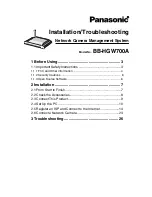
MEW-OS100LNW
Occupancy Switch With Nightlight
Please read all instructions before installation
SPECIFICATIONS
Voltage --------------------------------------------------------------------120VAC, 60Hz
Load (Single Pole Circuit)
Incandescent or fluorescent light -------------------------------------------0-600 Watt
LED Light ---------------------------------------------------------------------0-150 Watt
Fan motor ------------------------------------------------------------------------- 1/6hp
Time Delay ----------------------------------------------------------------- 1-60 Minutes
Environment ------------------------------------------------Residential Indoor Use Only
Operating Temperature --------------------------------- 32° to 131°F (0° to 55°C)
Humidity -------------------------------------------------- 95% RH, non-condensing
Tools Needed ------------------------------------ Insulated Screwdriver, Wire Strippers
DESCRIPTION AND OPERATION
The MEW-OS100LNW Occupancy Sensor is designed to replace a standard light or fan
switch. It is ideal for living and dining rooms, family rooms, bedrooms, bathrooms and
any other indoor areas in a residential space.
Like a standard switch, you press the manual button to turn the light or fan (controlled
load) ON and OFF. Unlike a switch, the MEW-OS100LNW automatically turns ON the
controlled load when occupancy is detected in the coverage area. The controlled load
turns OFF when the coverage area has been vacant for a predetermined period of time.
Nightlight
When the area around the switch is dark, the nightlight built into the MEW-OS100LNW
turns ON.
Time Delay
The time delay can be selected by the user during set up. It can be adjusted from 1
minute up to 60 minutes. For additional information on how to adjust it, please read the
SENSOR ADJUSTMENT & PROGRAMMING section of this installation manual.
COVERAGE AREA
The MEW-OS100LNW has a maximum coverage range of 150°-180° and a coverage area
of 600 square feet (56 square meters). The sensor must have a clear and unobstructed
view of the coverage area. Objects blocking the sensor
’
s lens may prevent detection
thereby causing the light to turn off even though someone is in the area.
Fig.1: Sensor Coverage Area
Windows, glass doors, and other transparent barriers
will obstruct the sensor
’
s view and prevent detection.
INSTALLATION & WIRING
1. Prepare the switch box.
After the power is turned off
at the circuit breaker box,
remove the existing wall plate
and mounting screws.
Pull the old switch out from
the wall box.
2. Identify the type of circuit.
In a Single Pole Circuit (see Fig. 2),
two single wires connect to two
screws on the existing switch.
A ground wire may also be present and connected to a
ground terminal on the old switch.
A neutral wire should also be present in the wall box. A NEUTRAL wire is REQUIRED
for MEW-OS100LNW.
CAUTION FOR YOUR SAFETY:
Connecting a proper ground to the sensor provides
protection against electrical shock in the event of
certain fault conditions. If a proper ground is not
available, consult with a qualified electrician
before continuing installation.
Fig. 2: Typical Single
Pole Switch Wiring




















